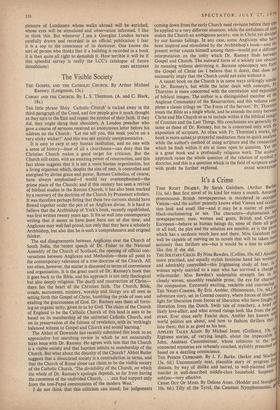Lambeth Walks SURVEY OF LONDON. Volume XXVI. THE PARISH OF
Sr. MARY LAMBETH, Part Two: Southern Area. Edited by F. H. W. Sheppard. (Athlone Press, 40s.) THIS great book, cheap at the price, is about a long strip of built-over land stretching from Vauxhall Bridge and the Oval cricket ground, south to the wooded slopes of Norwood. In fact it once was the southern part of the huge Surrey parish of St. Mary Lambeth. It is now LCC and about thirty parishes, most of them bombed. It is that land south of the river where even Londoners lose their way, thinking they are making for Claphart and finding themselves in Streatham, looking for Kent and brought face to face with the gate of Norwood Cemetery (laid out by sir William Tite, 1837, with King's Chapel on the cheap for mortuaries, and a Greek Temple, 1872, by J. 0. Scott). Here, in exact pages of description and many illustrations, is the history of the last century in brick and stone, mostly the former. The first surburban houses in Lambeth to be built by Londoners from over the river were along the turnpike roads. They are still to be seen, in elegant eighteen-twentyish terraces ripe for destruc- !leo, down the Brixton, Clapham and Camberwell new roads and In the late eighteenth-century houses of Kennington. This tradi- !i,00, a beautiful use of stock brick with stucco dressings, fan- ellhts and delicate verandas and porches, is London domestic at its best. It was well revived by Adshead and Ramsey (1913-15) in Courtenay Square, Kennington, mentioned, but not illustrated, here. Here and there stood its country boxes of which 30 Wands- Worth Road (1758) and Brockwell Hall (1811-13) are typical.
Tight boxes, neatly sash'd, and in a blaze
With all a July sun's collected rays, Delight the citizen, who, gasping there,
Breathes clouds of dust, and calls it country air Cowper wrote in `Retirement' (1782). Business men, such as „eskin's father, made for themselves a ms in urbe in the parish itttil the Fifties, and the most countrified survivor of these days is the windmill (1816-17) in Stockwell which worked until 1934. h The railways which run inconsequently to Victoria, London °ridge, Holborn Viaduct, Charing Cross and Cannon Street on swr.ehes and through cuttings acrop and across South Lambeth, „Ith their charmingly gimcrack stations and grimy junctions, "i ere the end of rus in urbe. They were built between 1856 and ,872. A less classy sort of person than Ruskin's father settled here "'sect the result is• little good domestic architecture and much o°e, culative building with which the great South London names a` Higgs and Hill are associated. Fields between the turnpikes jittl Parish roads were filled with streets like those described by eho Davidson (1897):
In gaudy yellow brick and red.
With rooting pipes like creepers rank.
The shoddy terraces o'erspread Meadow, and garth, and daisied bank.
I he dignity-of man was reasserted in the churches for the new rmrt,tourbs, of which the finest are St. Matthew's Brixton (1822-24), aeek, St. John the Divine Kennington, by G. E. Street (1871-74) b4c1 All Saints Rosendale Road, by Fellowes Prynne (1888-91), p?,th Gothic, and Christ Church North Brixton, by Beresford 4r"e (1902), Byzantine. St. Agnes Kennington is just outside the iibett• The civic pride of man shone out in town halls and public hirttries, not forgetting what must be the funniest public statue odon, that to Henry Fawcett the blind Postmaster-General to vauxhall Park (1893). It is in Doultonware and has panels 4,11t1d its sides symbolising Justice, Good and Bad News,
Pathy, Courage, Truth, India and the Post Office.
hi 'his, the twenty-sixth volume in its series, is something new ILstIrveys and, to my mind, more interesting than previous ones, l'hause less concerned with pre-history and antiquarian remains, qtere is virtually nothing in the area to record earlier than h, °rgian so that buildings of as late as 1908 are described. This have meant the exercise of great discrimination by the Mr. F. H. W. Sheppard, for he has had to select the best tim Most representative from many thousands of acres of streets. 11es shown taste and a sense of proportion. I do regret that he 11ot included the better and more prominent commercial wet4itogs of Lambeth, like theatres and large shops, and the wet der public houses. But we cannot have everything and what tile,11,ave is all worth the trouble that has been taken over it. The Ttogtod is to divide the parish into known areas, such as Brixton, Hill, Vauxhall, etc.. and subdivide these into the speculative CheL4tes developed when land was sold by the early owners. Of eh se subdivisions there are maps, and all worthy houses, chapels, millrehes and public buildings on them are described and often bk°t°graphed or drawn in elevation or in plan. What tales of truptcies, rises to fame and struggles by tenants does one IT' into these bald descriptions! What odd pieces of information 41/„ear, such as that of the inscription on a sundial in Ruskin Herne Hill, which says, `Here stood the house where eoklelssohn wrote the Spring Song, 1842!' ,ilbn,e asks oneself to what end was this book written (and sidised) by the LCC? I like to think that it is written for the
pleasure of Londoners whose walks abroad will be enriched, whose eyes will be stimulated and observation informed. I like to think this. But whenever I see a Georgian London terrace carefully drawn and recorded in an official publication I fear it is a sop to the conscience of its destroyer. One knows the sort of person who thinks that if a building is recorded in a book it is then quite all right to demolish it. How terrible it will be if this splendid survey is really the LCC's catalogue of future




































 Previous page
Previous page